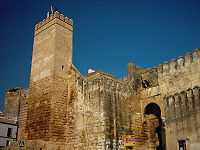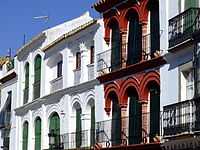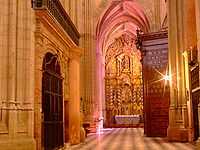Carmona, Spain
| Carmona | |||
|---|---|---|---|
| Municipality | |||
 | |||
| |||
 Carmona | |||
| Coordinates: 37°28′N 5°38′W / 37.467°N 5.633°WCoordinates: 37°28′N 5°38′W / 37.467°N 5.633°W | |||
| Country |
| ||
| Autonomous community |
| ||
| Province | Sevilla | ||
| Comarca | Campiña de Carmona | ||
| Government | |||
| • Mayor | Antonio Cano Luis (PSOE) | ||
| Area | |||
| • Total | 924.12 km2 (356.80 sq mi) | ||
| Elevation | 253 m (830 ft) | ||
| Population (2011) | |||
| • Total | 28,679 | ||
| • Density | 31/km2 (80/sq mi) | ||
| Demonym | Carmoneses or Carmonenses | ||
| Time zone | CET (UTC+1) | ||
| • Summer (DST) | CEST (UTC+2) | ||
| Postal code | 41410 | ||
| Website | Official website | ||
Carmona is a town of south-western Spain, in the province of Seville; it lies 33 km north-east of Seville.
Carmona is built on a ridge overlooking the central plain of Andalusia; to the north is the Sierra Morena, with the peak of San Cristobal to the south. The city is known for its thriving trade in wine, olive oil, grain and cattle, and holds an annual fair in April.
History
Carmona, known as Carmo in the time of Julius Caesar (100–44 BC), was a Roman stronghold of Hispania Baetica. The city was made even more impregnable during the long occupation of the Moors, who erected walls around it, and built fountains and palaces within. In 1247, Ferdinand III of Castile captured the town, and bestowed on it the Latin motto Sicut Lucifer lucet in Aurora, sic in Wandalia Carmona ("As the Morning-star shines in the Dawn, so shines Carmona in Andalusia").
Climate
Carmona has a Mediterranean climate with a sunny spring and typically some rain in that season. In October, the average temperature ranges from a minimum of 13 °C to a maximum of 26 °C. The city experiences a moderate level of annual precipitation and has pleasant winter temperatures.
Main sights


- Palace of King Don Pedro, built in the 13th century by Peter I of Castile. It was damaged by an earthquake in 1504.
- Palace of Rueda
- Palace of the Marquess of Torres
- Seville Gate Palace
- Baroque palaces of Alonso Bernal Escamilla, Aguilar, Domínguez, and Lasso
- Córdoba Gate, the gate on the road to Córdoba, partly of Roman construction
- Seville Gate, of Carthaginian origins, has the remains of later Roman additions, and was modified in the Middle Ages by the Moors and the Christians.
- Marchena Gate, built during the Almohad domination of Spain
- Roman Bridge
- Remains of the Via Augusta
- Tree-lined avenue of Alfonso XIII
- Roman Necropolis, discovered in 1881. It is located close to the town, beside the Seville road, and contains many sepulchral chambers hewn in rock, with niches for the cinerary urns, and occasionally with vestibules containing stone seats (triclinia).
- The Tomb of the Elephant and the Tomb of Servilia in the necropolis
- Roman Amphitheatre, also discovered in 1881, together with a group of tombs, all belonging to the first four centuries AD, near the original necropolis.
- Ayuntamiento (Town Hall)
- Cave of the Batida
- Fountain of the Lions
- Hospital of the Mercy and the Charity Church of Saint Bartholomew
- Tower of the Peak
- Market
- Cerezo Theatre
- Religious buildings

- Church of San Pedro (15th century). Its tower is a replica of the Giralda bell tower of the Cathedral of Seville.
- Church of Santa Maria de la Asunción
- Church of El Salvador (17th century), in Baroque style
- Church of the Convent of Santa Ana
- Church of San Blas
- Church of San Felipe (14th century)
- Church of Santiago
- Convent of the Immaculate Conception
- Convent of the Trinity
- Convent of Las Descalzas Discalced Carmelite Nuns
- Convent of Santa Clara (15th century), with a Mudéjar church renovated in 1664 in Baroque style
- Hermitage of San Mateo (15th century)
- Hermitage of Our Lady of Real or San Antón (15th century).
- Ermita de la Virgen de Gracia (Our Lady of Grace, the patron saint of Carmona)
Gastronomy


Carmona's restaurants and bars demonstrate a variety of Spanish cuisine including tapas and other dishes. The city is known for its traditional Andalusian cooking. A pub crawl of various bars, called the Ruta de las tapas (Tapas Route) is noteworthy; it is marked with blue and white signs, and even appears in the seal of the city.
Typical Carmonan dishes include: sopa de picadillo (a chicken soup), pringá, chickpeas, snails, salmorejo, spinach, tagarnina (thistles), serrano ham, partridge from the mountains, gazpacho, chickpea soup, tomato soup, potatoes, and cuajados (curdled eggs).
Sweets include: English cake, hojaldres (puff pastry), rice with milk, torrija (French toast), polvorónes (shortbread), almond cakes, chestnut stew with cinnamon, porridge sprinkled with cinnamon, and cortadillos (sweet cakes). A variety of desserts are made in the convents of the city, mainly by the nuns of Santa Clara.
A common alcoholic beverage is Anise Los Hermanos, which is distilled and packaged in Carmona; it comes in three degrees of dryness: crisp, sweet and semi.
Films
With its rich historical and artistic patrimony lending the city an especially atmospheric appearance, Carmona has been the setting of numerous films,and continues to attract movie crews. The Location Managers Guild of America, an association that coordinates shoot locations for movie and television production companies from the United States, has shown special interest in the city centre.
See also
- The Roman Bética Route
External links
- Tourism Office
- Carmona Film Office (Spanish)
- Museum of the city of Carmona (Spanish)
- Pgou of the city (Spanish)
References
 This article incorporates text from a publication now in the public domain: Chisholm, Hugh, ed. (1911). Encyclopædia Britannica (11th ed.). Cambridge University Press
This article incorporates text from a publication now in the public domain: Chisholm, Hugh, ed. (1911). Encyclopædia Britannica (11th ed.). Cambridge University Press

